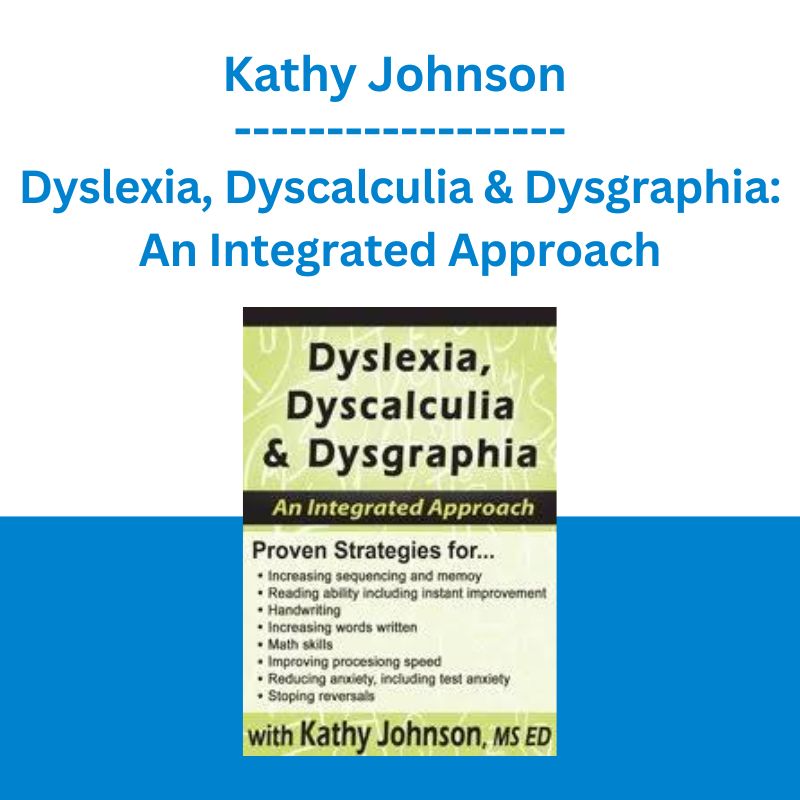*** Proof of Product ***
Exploring the Essential Features of “Kathy Johnson – Dyslexia, Dyscalculia & Dysgraphia: An Integrated Approach”
Description
Strategies for…
- Increasing sequencing and memory
- Reading ability including instant improvement
- Handwriting
- Increasing words written
- Math skills
- Improving processing speed
- Reducing anxiety, including test anxiety
- Stopping reversals
In this recording, professionals from many different perspectives come together to learn how their interventions integrate to remediate some of the more complicated dysfunctions seen in education. The Pyramid of Potential approach starts the remediation with building blocks of mind and body health from the nutrition and psychology disciplines. This is followed by neurodevelopment and sensory-motor development from occupational therapy, physical therapy and vision therapy disciplines. Finally, cognitive skills training, such as memory, attention, and processing speed, come from education.
This program combines lecture and notes with discussion and hands-on exercises to help facilitate different learning styles.
Speaker
Kathy Johnson, MS Ed
Kathy Johnson, MS Ed., has been working with students since 2000 to overcome their reading struggles, as well as other learning issues. She found an excellent program that brought their decoding abilities to grade level in a matter of months. Yet, some could not read the test in grade level books, so she began her exploration into the trainings and therapies that brought students’ success. Many increased their IQ and no longer required extra services. Kathy received training in order to bring these therapies to others which include Primitive Reflex Training by Samuel A. Berne, OD, Therapeutic Listening by Sheila Frick, Samonas Listening by Jill Stowell, PACE by Learning Rx, Phono-Graphix by Read America, Irlen Syndrome, Brain Gym 101, and An Introduction to Rhythmic Movement.
In 2000, Kathy started The Hunter School of Ballston Spa for struggling students, in which she and her assistant taught third through eighth graders required academics while remediating their struggles through therapy during the school hours. In 2002, she started an educational consulting business to screen and remediate student struggles individually. Since then she has also given lectures and workshops to clinics and schools, been a guest on Internet talk radio shows, and wrote The Roadmap from Learning Disabilities to Success plus other DVDs and publications. Kathy earned her Master’s degree from the State University of New York at Albany where she instructed faculty and staff, was an adjunct professor at Schenectady County Community College, and taught at The Adirondack School of Northeastern New York.
Speaker Disclosures:
Financial: Kathy Johnson maintains an educational consulting firm, Pyramid of Potential. She has authored a series of workbooks and CDs, The Pyramid of Potential Series. She is a compensated author for ZLS Publishing. She receives a speaking honorarium from PESI, Inc.
Nonfinancial: Kathy Johnson has received training in Therapeutic Listening and Samonas Listening.
Target Audience
Counselors, Teachers/Educators, Occupational Therapists & Occupational Therapy Assistants, Psychologists, Social Workers, Speech-Language Pathologists, and other Mental Health Professionals.
Objectives
- Breakdown the common causes of Dyslexia, Dysgraphia, and Dyscalculia to inform the clinician’s choice of treatment interventions.
- Analyze the efficacy of the integration of many professions, such as education, occupational therapy, physical therapy, nutrition, psychology and others and identify how the integration of these professions can alleviate symptoms of Dyslexia, Dyscalculia and Dysgraphia.
- List the underlying areas of brain development to improve client academic engagement.
- Administer hands-on cognitive development activities to put to practical use in-session.
- Analyze the clinical implications of visual and auditory processing difficulties and identify areas of improvement as it relates to clinical outcomes.
- Create a systematic plan of interventions to improve level of functioning in clients with Dyslexia, Dyscalculia or Dysgraphia.
Outline
Introduction
- Dyslexia, Dysgraphia and Dyscalculia definitions
- Common causes, similar approaches
- The Pyramid of Potential – brain development
Mind and Body Health
- Nutritional needs for healthy brain function
- Role of exercise and sleep
- Stress: physical and emotional
Brain Development and the Primitive Reflexes
- How to test and integrate the reflexes – video and practice
- Moro and Dyscalculia
- Palmar – Dysgraphia
- Tonic Labyrinthine – Dyslexia, Dyscalculia, and Dysgraphia
- Spinal Galant – Dyslexia
- Asymmetrical Tonic Neck Reflex – Dyslexia and Dysgraphia
- Symmetrical Tonic Neck Reflex – Dyslexia, Dyscalculia, and Dysgraphia
Sensory Development – Auditory
Processing Disorder
- Diagnosis
- Listening therapy
- Listening devices
Sensory Development – Vision
- Screening for tracking and convergence
- Simple eye exercises
- Irlen Syndrome – colored overlays
- Vision therapy
Cognitive Development
- Skills: Phonemic awareness, memory, processing speed, attention, logic and more
- Hands-on activities
- Programs or create your own program
- Create a sample plan of intervention for LD students
Review
- Brainstorm: 10+ strategies for improving test scores
Please see the full list of alternative group-buy courses available here: https://lunacourse.com/shop/









